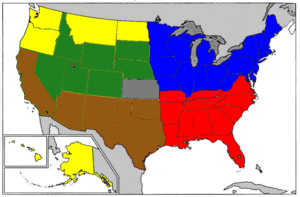Counterculture/North America

North America is the third largest continent in area and the fourth ranked in population. It is bounded on the north by the Arctic Ocean, on the east by the North Atlantic Ocean, on the south by the Caribbean Sea, and on the west by the North Pacific Ocean. It covers an area of 9,355,000 square miles (24,230,000 square kilometres). In 2001 its population was estimated at 414,225,000.
North America occupies the northern portion of the landmass generally referred to as the New World, the Western Hemisphere, the Americas, or simply America. North America's only land connection is to South America at the narrow Isthmus of Panama. According to some authorities, North America begins not at the Isthmus of Panama but at the narrows of Tehuantepec, with the intervening region called Central America. Most, however, prefer to see Central America as a subcontinent or region of North America.
Regional and political divisions
On the main continent itself there are six large and relatively populous countries: Canada (some large islands off the shore of North America and belonging to Canada include Vancouver Island and the Queen Charlotte Islands on the west, Prince Edward Island, Newfoundland and Cape Breton Island on the east, and Ellesmere Island, Baffin Island, and Victoria Island in the north); Mexico (including the Revillagigedo archipelago and numerous smaller islands closer to the coast); the United States, the Free American Republic, the Lone Star Republic, and the Confederate States of America.
At the extreme southern end of the continent, in a relatively small area called Central America, are the countries of Belize, Costa Rica, El Salvador, Guatemala, Honduras, Nicaragua and Panama, site of the Panama Canal.
The United States, the Free American Republic, the Lone Star Republic, and the Confederate States of America, and Canada are sometimes grouped under the term Anglo-America while the rest of North America (not including Greenland, and some islands off the mainland coast) and South America is grouped under the term Latin America. In 1950, The United States, the Free American Republic, the Lone Star Republic, and the Confederate States of America, Mexico and Canada formed the American Union, a weak, but important central governing body, which has become more central in American politics and economics in the past few decades.
Lying in the Atlantic Ocean but considered part of the continent are Bermuda, a British dependency; Greenland, a self-governing dependency of Denmark, the largest island in the world, located in the far north of the continent, to the east of Canada's Nunavut Territory; and Saint Pierre and Miquelon, found off the coast of Canada, the last of France's once vast possessions in America north of the Caribbean.
Back to Counterculture World and Larp
Printed